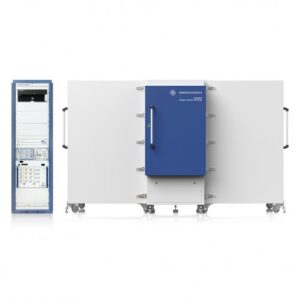Smart waste management of biowaste increases recycling rates and minimises residual waste volumes

Smart waste management is one of the core tasks within smart cities, i.e. those urban areas in which innovative technologies and data-driven solutions are used. They aim to improve the quality of life of residents, minimise environmental impact and use resources more efficiently. Conserving resources is not just about recycling, but also about innovative approaches to collecting waste and then disposing of or processing it in the best possible way. One of the most important components of smart cities is therefore the introduction of efficient waste collection systems. In addition, from 1st May 2025 at the latest, waste from organic waste bins delivered for composting or fermentation in Germany may only contain a maximum of 3.0 percent by weight of foreign matter when delivered. The German company c-trace GmbH meets this challenge with its AI solution c-detect. The industry specialist for IT solutions for all aspects of waste disposal logistics specialises in telematics solutions for the trouble-free collection of organic waste from households. The purer the biowaste is delivered, the lower the effort and costs for the removal of foreign matter. In addition, the quantity and quality of compostable biowaste is increasing and with it the marketable end product, which has developed into an important raw material over time. The company has developed the first artificial intelligence (AI)-based system for detecting impurities during organic waste collection in order to ensure the highest possible purity of organic waste for further processing. IDS cameras as the reliable eyes of refuse collection vehicles “Contaminants in biowaste, especially plastics, cause high costs and make recycling time-consuming or even impossible,” explains c-trace sales engineer Jan Birkhold. The c-detect computer vision system combines the system house’s intelligent software with extremely robust and powerful uEye FA industrial cameras from IDS to view the contents of the organic waste bin using either “TopView” or “InsideView”. With the help of two cameras per system variant, c-trace can use object detection to identify all relevant types of materials and objects that have no place in biowaste. It detects trained contaminants such as plastic bags or metals and will also be able to distinguish between normal and biodegradable plastic bags in the future. Both static image recordings (TopView) and dynamic image recordings in the pouring process (InsideView) are recognised, processed and documented via image verification. The content is immediately evaluated in the vehicle using trained artificial intelligence. The analysis of the detection can be tracked in real time directly in the vehicle via a powerful AI on-board computer and the associated c-ident touch board. In the event of detection, an evidence photo is saved and automatically forwarded for analysis. TopView cameras look at the open waste bin from above InsideView cameras look into the pouring chamber The TopView variant utilises the view from above into each organic waste bin. For this purpose, two cameras are installed at the rear of the collection vehicle, above the bulk material. As soon as the system recognises impurities on the surface of the open organic waste container, the waste collection vehicle’s dumping process is automatically stopped. “Thanks to the configurability of the system, it is possible to set the impurities for which the system should respond, depending on the degree of contamination,” explains Jan Birkhold. “As soon as impurities are detected in the container, it is left unemptied so that the impurities do not enter the collection process.” Detected waste TopView The InsideView variant, on the other hand, uses two cameras in the pouring chamber. They are directed at the side of the bins and record images of the waste with high resolution and frame rate during the emptying process. If there are any foreign substances under the surface, these are also detected and documented when the container is emptied. The system also triggers an optical signal on the InsideView directly on the waste collection vehicle so that the refuse collector can provide the citizen with a sorting notice for the contaminated container. In addition, the recorded image evidence offers the possibility of repeatedly contaminated and emptied containers being billed to the citizen as more expensive residual waste emptying in order to involve him directly in the higher disposal costs. A combination of both variants is also possible. In this case, up to four IDS cameras on the collection vehicle take over the automatic control. Detected waste InsideView The vehicle data record is transferred with the corresponding image, GPS coordinates and transponder number in real time to the waste disposal company and the client (district or city) in the c-ware AIR software for evaluation or direct complaint processing. “Fast image processing is particularly important here. We were looking for a network-compatible, high-resolution camera that can be programmed independently,” says Jan Birkhold, explaining the choice of camera model. Other decisive criteria included size, automatic exposure setting, protection class, robustness and stability in camera operation. The GigE Vision® IDS camera, which c-trace utilises, is equipped with the compact 2/3″ global shutter CMOS sensor IMX264 from Sony and ensures outstanding image quality, light sensitivity and an exceptionally high dynamic range. It has an internal 120 MB image memory and delivers virtually noise-free, high-contrast 5 MP images in 5:4 format at 22 fps, making it ideal for applications such as these with fluctuating lighting conditions. The IP65/67 protection class protects against dirt, dust and splash water – a must for use on refuse collection vehicles. Another advantage of the integrated IDS cameras is their easy integration thanks to IDS peak. “Our developers benefit from the network compatibility, support for the C++ programming language and a large number of features within the programming environment,” says Jan Birkhold. The data collected enables the biowaste to be reliably allocated to the respective bin or waste producer. Corresponding heat maps can be generated using the GPS coordinates. “Our customers use RFID transponders, which guarantee extremely high read rates and make the bins unmistakable, enabling direct allocation of the emptied bins to the citizen,” explains Jan Birkhold. TopView Interference detection heat map c-ware All data can be viewed in real time and subsequently analysed. The inspection and evaluation of organic waste not only serves to sensitise the population to the need to dispose of unmixed organic waste, but also as a basis for decisions on material flow management. The separate processing of heavily soiled batches is controlled in a targeted manner, which reduces the processing technology and operating costs of disposal. “The uEye FA cameras become the unwavering eyes of refuse collection vehicles and support c-trace customers in improving the quality of biowaste,” says IDS Managing Director Jan Hartmann, delighted with the resource-saving use of the IDS cameras. The AI-based software from c-trace learns continuously and thus constantly improves sorting purity and recycling rates. Together, the two components ensure the minimisation of residual waste, targeted material flow management, fewer microplastics in compost and, last but not least, greater recycling awareness among the population. “The use of c-detect enables local authorities to document and analyse contaminants in biowaste sustainably, cost-effectively and effectively and to take appropriate measures to meet the increasing requirements of the biowaste ordinance,” emphasises Jan Birkhold. “For cities and municipalities, it is increasingly about improving material cycles and flows at regional and local level,” adds Jan Hartmann. “This optimisation of regional material cycles can lead to considerable resource conservation, and image processing technology can make an important contribution to this.” Outlook For greater efficiency and sustainability, a camera system is to be used in future that will take event-related, data protection-compliant video recordings of unprovided waste containers in a defined radius of the expected container location on the collection vehicle. The c-gap vehicle system only records video footage if a transponder on a collection day’s order route is not read by the identification system, as it is then assumed that a container has not been provided. This allows specific proof to be provided as to whether or not a complaint or subsequent journey for a container that has not been emptied is justified. The c-gap solution can save many kilometres and costs for waste disposal companies. This shows promising approaches that AI already offers smart cities for the development of waste management and how it can support the necessary change. Districts, cities, municipalities and waste management companies must increasingly address this issue in order to meet the challenges of the future and work even more efficiently and in a way that conserves resources. Client Since its foundation in 2005, c-trace GmbH has grown considerably and is now the industry specialist for IT solutions for all aspects of waste disposal logistics. The Bielefeld-based company offers districts, cities, municipalities and public and private waste disposal companies integrated, scalable system solutions to optimise waste disposal and thus make it more economical. The systems make information visible, reveal potential and optimise work and logistics processes in the office and on the road. Innovative telematics solutions based on the IoT are developed in the in-house Digital Lab to make waste logistics more intelligent. Camera uEye FA – the most robust and resistant industrial camera with PoE Model used: GV-5280FA-C-HQ Kamerafamilie: uEye FA
IDS Imaging Development Systems GmbH
Dimbacher Str. 10
74182 Obersulm
Germany
KIRSCH Claudia
Phone : +49 7134 96196 0
c.kirsch@ids-imaging.de


